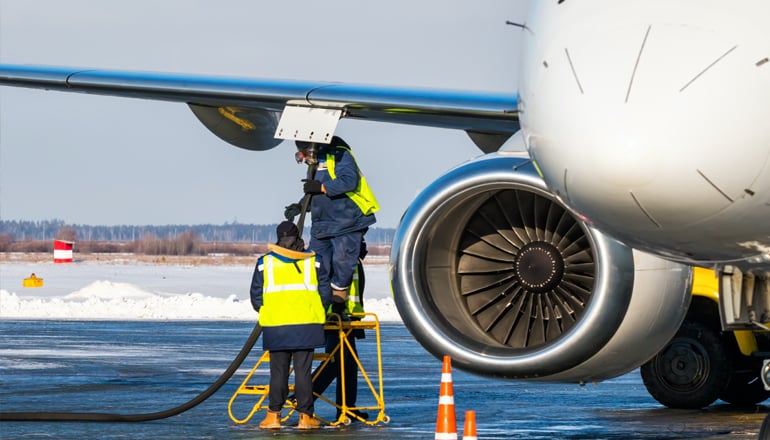Unless you have managed to stay indoors for the past year, you have undoubtedly noticed your fuel bill rising. But, of course, it isn’t just your fuel bill for your car or truck; it manifests itself in every single consumable item you purchase.
It was shipped there on trucks, trains, planes, and ships if you bought it. These are all fossil-fuel powered and probably will be for the foreseeable future, although the global initiative fingers 2050 as the goal for sustainable transportation. In the meantime, commercial aviation will continue to rely heavily on fossil fuels for energy. Here is how your operation can reduce dependency on fossil fuels while reducing the strain on your workforce.
Fuel Price Hikes: Where is it Coming From?
The fuel price dropped through the floor in early- to mid-2020, unarguably impacted by the almost instantaneous ceasing of all global activity. It seems like a lifetime ago, especially as we have watched fuel prices soar to all-time highs. Price drops were so dramatic that Brent Crude, running around $70 per barrel, toppled down to $9.12 on April 21st.
The market was faced with a severe dilemma: airlines were grounded everywhere, the same airlines burning roughly 1.8 billion gallons per week in 2019. You cannot turn off the flow of crude oil throughout the world at a moment’s notice. The world’s oil supply is built around projected demand, and when the bulk of the world’s automobiles and aircraft activity came to a screeching halt, something had to be done with the oil drillers pumped.
But that was two years ago. Most of the world is fully re-opened, and according to the IATA, jet fuel has spiked 57% since last year. The reasons for spiking fuel prices are numerous and problematic, but ultimately it comes down to simple supply and demand: two years ago, there was adequate supply, and then the demand came crashing.
There is significant demand with on-site work back in full swing, along with regional, national, and global air travel for business and pleasure. However, the supply is now short. Why? Demand all but capped production. And not only were the mechanical mechanisms for oil production stopped, but then crippling rules regarding how the workforce would be allowed to work near each other remained for months after demand began to creep upwards.
In other words, oil producers and refiners could not increase output when they were being forced only to have half of a workforce on-site at any given time. On top of that, we are experiencing ‘The Great Resignation,’ a global condition witnessing a higher-than-average quit rate of employees. Even as restrictions began to wane, critical positions across all industries have remained unfilled for months as qualified people are leaving in droves. In a technical field like oil drilling and oil refining, new employees' training and learning curves are long, slowing down the process even more. When you add all of these factors up, you will see a recipe for disaster.
What Does The Future Look Like?
Unfortunately, the consensus is in, and it does not appear optimistic. The demand is on the rise for air travel and will likely become even more prominent as most Western countries have primarily dropped entry restrictions. With that being said, though, the 2022 fuel projection is still below 2005 use.
The significant difference is that in 2005, the oil industry tailored the output for consumption; they weren’t rewriting the script of fuel production or fuel use. Instead, fuel was being produced at the rate users consumed it, plus reserves.
A few prominent companies are working towards sustainable aircraft power production and fuels, namely hydrogen, but they are still some ways off from full-scale production. Sustainable aviation fuels (SAFs) are incredibly costly to produce and take a long time to kick into full production. So, we are stuck using fossil fuels for a while, and it appears as though that will be extensive.
The worse news, which none of us need to hear, is that they probably haven’t plateaued and will continue to increase.
Whatever the price, air travel, and air freight are not going anywhere. The global air freight fleet is set to grow exponentially, with Boeing expecting the fleet to grow by seventy percent through 2040. As a result, the price of jet fuel will be absorbed into the cost of goods and services.
Transitioning to Electric GSE is Viable
It is easy to feel that we bear the brunt of the financial impact in times like these. Operators feel it. There has been a shortage of technicians and pilots for several years now, and the Great Resignation is doing no favors in this respect.
Suppose the fuel price is impacting our bottom lines (the consumer). But unfortunately, it is also crushing aerial operations, especially those that do not have bottomless pockets like the legacy carriers do. Or the aviation operations that do not have the clout to receive massive government bailouts.
These are the corporate and charter operations and the MROs. These are the aero-medical operators with a fleet of helicopters tasked with saving lives. So how can you possibly find any margin in the books to stave off inflated fuel prices?
The obvious answer is to use clean, renewable electrical power anywhere you can. If you cannot power aircraft electrically, you can undoubtedly implement electrical GSE into your ground operations.
Powered GSE burns hundreds of gallons of diesel per year, per unit. But that is not the only advantage of transitioning to electrically powered GSE; in light of the Great Resignation, work teams have been gutted, leaving no margin for menial tasks like aircraft movements.
Fuel Savings
With budgets being stretched thin, updating GSE is not always a high priority. Keeping jets in the air is the priority, but at some point in time, you need to assess your support infrastructure and how it is impacting your overall bottom line.
Diesel GSE has proven to be highly reliable over decades, but it has limitations. The technology has been mainly unchanged in the past three or more decades. Industrial diesel engines haven’t changed much, nor have the industrial machines they power.
How much diesel is burning idling GSE? A 2018 article indicated that trucks burn about four billion gallons of diesel over the road annually. The national average price of diesel is $5.16, resulting in over $20 billion on idling engines—a billion with a B.
Aircraft GSE is a smaller demographic, but you can understand the parallel. Idling burns into your bottom line, adding undue wear and tear on diesel engines. Constant turning off and restarting diesel engines.
Electric GSE is clean, relying on the power that is already being harvested from the sun and wind. This is only going to scale up from where we are now. Also, electric tugs are virtually maintenance-free instead of maintenance-heavy diesel units.
Manpower Constraints
Aircraft towing operations are taxing on personnel at the best of times because of the team size required (usually five or six when moving in and out of hangars). In an era of technician shortages that are not letting up, this takes five workers away from other tasks that are less mundane.
A towbarless tug is built to allow an entire team of technicians to be condensed into one or two individuals. Since it is remote-controlled, the operator has the flexibility to walk around the aircraft during movement and stop it instantly to make corrections and check for clearance. That affords your operation hundreds of manhours that it was otherwise committing to a simple but critical task. Those can go back into inspections, overhauls, and repairs.
Conclusion
The demand for air travel is on the rise, and the demand for air freight is reaching historical heights. However, the fuel price is also hitting record highs and still climbing. Therefore, it is in your best interest to shore in the lines and create a margin. It is a real 1-2 punch when coupled with crippling manpower shortages. You cannot control all of these variables, but you can control GSE that uses no fossil fuels and reduces your staffing footprint. Give us a call, and we can talk you through which Mototok tug is the best fit for your operation!



Comments